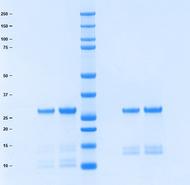
Cathepsin D
Product Sizes
0.025 mg
16-12-030104-0.025MG
0.05 mg
16-12-030104-0.05MG
0.1 mg
16-12-030104-0.1MG
1 mg
16-12-030104-1MG
About this Product
- SKU:
- 16-12-030104
- Additional Names:
- Cancer, Alzheimer's,In Vitro Diagnostic|CatD,CTSD, CPSD
- Buffer:
- Lyophilized from 2 mM Na phosphate, pH 6.5.
- CAS Number:
- 9025-26-7
- CE/IVD:
- RUO
- Extra Details:
- Cathepsin D (CatD), a lysosomal aspartyl protease encoded by the CTSD gene, functions in protein degradation and activation of bioactive precursors through cleavage at acidic pH. Its structure includes a signal peptide, propeptide, and catalytic domain with two aspartic residues essential for enzymatic activity. Estrogen receptor (ER) signaling drives CatD overexpression in hormone-responsive breast cancers via TATA-dependent transcription initiation, mediated by upstream stimulatory factors USF-1/USF-2 binding to E-box elements. In ER-positive tumors, CatD secretion promotes metastasis by degrading extracellular matrix components and enhancing cell motility. Clinically, CatD expression correlates with aggressive breast cancer phenotypes, including high histological grade, and reduced survival. In Alzheimer's disease (AD), CatD colocalizes with amyloid-B Beta (AB Beta) plaques and neurofibrillary tangles, where it degrades both AB Beta42 and tau under normal conditions. However, AB Beta42 accumulation competitively inhibits CatD, impairing tau clearance and exacerbating neurodegeneration. Cigarette smoke elevates CatD activity in alveolar macrophages and bronchoalveolar lavage fluid, contributing to emphysema via lung matrix degradation. Therapeutically, CatD serves as a prognostic biomarker for breast cancer stratification and a predictor of tamoxifen resistance. Inhibitors like pepstatin A and small-molecule analogs targeting its active site are under investigation for metastatic breast cancer and AD3. In smokers, monitoring BALF CatD levels (>3,600 U/mL) may identify early lung damage, guiding preventive interventions. These dual roles in proteostasis and disease underscore CatD's potential as a multifunctional therapeutic node.
- Formulation:
- Lyophilized from 2 mM Na phosphate, pH 6.5.
- Molecular Weight:
- 42,000 Da
- Physical State:
- Lyophilized
- Purity:
- ≥95%
- Purification:
- Liquid Chromatography Methods
- Shipping Conditions:
- Blue Ice
- Source:
- Prepared from liver shown to be non reactive for HBsAg, anti-HCV, anti-HBc, and negative for anti-HIV 1 & 2 by FDA-required tests.
- Storage Conditions:
- Please refer to datasheet
- Supplier:
- Athens Research & Technology Inc.
- Type:
- Proteins, Peptides, Small Molecules & Other Biomolecules: Enzymes


